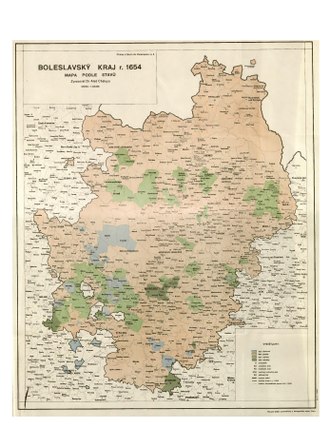Bunzlauer Kreis
The Bunzlauer circle ( Boleslavsky kraj ) was an administrative district in the northeastern part of the Kingdom of Bohemia , named after the town Jung-Bunzlau ( Czech : Mladá Boleslav ), the District Chief had its headquarters in this city.
It belonged to the old Bohemian circles and was reorganized in 1748 according to the administrative reforms of the time. With the administrative reforms after 1848, the districts functioned only as a supervisory authority and were replaced in 1867 by the more delicate system of political districts (see list of districts in Bohemia ).
Residents
The district included 68 dominions and 84 administrative offices. These included 37 cities, 8 market towns and 1038 villages and 1500 layers .
The population of the district is given on the basis of the 1843 census as 443,860 people. German was spoken in 352 municipalities, but Czech in 561 municipalities . In the northern sections of the district, the Czech language was practiced particularly pure.
The population at that time was predominantly Catholic . A small number confessed to the Augsburg or Helvetic denominations. Around 1845, 419 families in the Bunzlauer Kreis stated that they belonged to the Israelite community.
Geographical description
By 1845 the area of the Bunzlauer Kreis was 71.26 square miles .
The larger villages in the district included Benatek , Dauba , Friedland , Gabel , Gablonz , Jung-Bunzlau , Kratzau , Lissa , Melnik , Münchengrätz , Nimburg , Niemes , Reichenberg , Sobotka , Turnau and Weißwasser .
The landscape in the district is partly mountainous and partly flat undulating. The mountains include the Lusatian Mountains , the Zittauer and Jeschken Mountains and the Jizera Mountains . Furthermore, the north-eastern foothills of the Bohemian Central Mountains , the Daubaer Schweiz and the Bohemian Paradise are located in the district .
The larger rivers in the former district include the Elbe , Iser , Lausitzer Neisse , Pulsnitz , Kamnitz , Wittich and, on its western section, the Vltava .
Agriculture and Forestry
The valuable areas for field management are in the center and south of the district. The cultivation of crops has been widespread in the vast plains for a long time. Around 1845, wheat , rye and barley were the most important types of grain. Oats were grown in the mountainous agricultural areas. The most common crops were potatoes , rapeseed , legumes , flax and hemp .
The fruit growing had its large share in the agricultural use in the south and southwest of the district. Viticulture in the areas around Melnik, Lissa and Benatek was important for Bohemia .
In the cattle industry in the Bunzlau district around 1845, sheep farming was in the lead with 114,707 (1840: 111,420) animals. Only in second position came cattle breeding with 68,306 (1840: 72,738) cows , (1840: 12,870) 11,665 oxen . Furthermore, 18,000 (1840: 33,633) pigs , 13,000 goats and 2,000,000 geese were kept here . At this time there were 12,432 (1840: 12,869) horses in the district . Of the wild animals around 1840, the hares and partridges were the common hunting objects in the flat country. Among the population of the mountain areas, the interest in their game use was directed towards the capercaillie and the black grouse , and more rarely the hazel grouse . Vogelstellerei was widespread in the industrialized mountain areas .
In the Bunzlau district there were 2 industrial factories and 419 smaller businesses that worked and processed animal hides and hides .
Eels and eel rods were caught by using the natural fish stocks in the rivers, and mainly trout in the mountain streams . The fish farming in ponds focused on pike and carp . The annual fish yield in the Bunzlauer Kreis around 1845 was 1,920 quintals.
The higher mountains in the Bunzlauer Kreis were covered with coniferous forests. The spruce came first. Further conifers were added in the low mountain range. For forestry purposes, deciduous trees such as beech and birch came into question. In the southeast of the district pine and oak predominated in the forest stands .
Mining industry and other mineral raw materials
For building purposes, slate and sandstone were extracted in several places. Used mineral springs were in Bad Liebwerda , Wartenberg and Gutwasser around 1845 .
location
Adjacent counties and areas around 1845 were:
- in the north: Kingdom of Saxony and the Prussian province of Silesia
- in the west: Leitmeritzer Kreis and Rakonitzer Kreis
- in the south: Kaurimer district
- in the east: Königgrätzer Kreis
See also
literature
- Friedrich Carl von Watterich von Watterichsburg: Concise dictionary of regional studies of the Kingdom of Bohemia . 2nd edition, Prague (CW Medau and Comp.) 1845, pp. 428-433 online
- Johann Gottfried Sommer : The Kingdom of Bohemia: statistically topographically represented. Second volume. Bunzlauer Kreis . JG Calve, Prague 1834 online
Individual evidence
- ↑ Watterich, 1845, p. 276, table absolute population of the individual districts and the capital Prague
- ^ Watterich, 1845, pp. 6-7 Agriculture
- ↑ a b Watterich, 1845, pp. 71-73, Animal raw products production
- ↑ Watterich, 1845, p. 77, Animal raw products refinement

